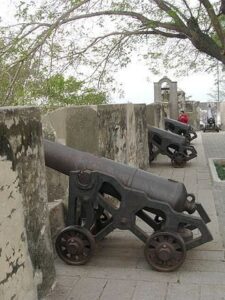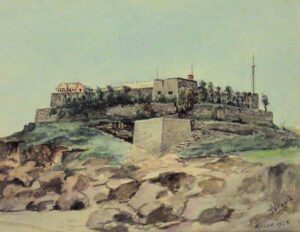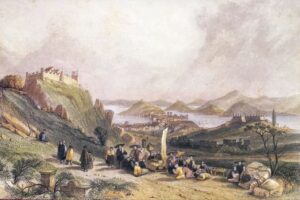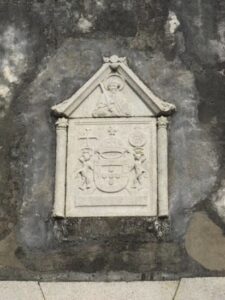MONTE FORT
by Dr Stuart Braga
Originally published in Casa de Macau Australia News, April 2014, Vol 27 Issue 3

You step onto the escalator taking you up into the Macau Museum and you glide past an ancient wall that looks as though it has always been there. Once inside, you see a fine display on the history of the various cultures that have shaped modern Macau. If you ever go to Macau, this major museum is a must. Escalators take you up several levels, and eventually you step out onto the flat top of the ancient fort. Around you are battlements and embrasures, some with cannon aimed out over the city below. These are not the originals, dating from about 1860, about 250 years after the fort was completed.

The original name of the fort was Fortaleza de Nossa Senhora do Monte de São Paulo, in English: Fortress of Our Lady of the Mount of St. Paul. The name suggests a religious origin. So indeed it was. Macau was the furthest outpost of a far-flung Portuguese empire that stretched along the African coast, with substantial strongpoints at Ormuz in the Persian Gulf at Daman in India.
Further east was an immensely strong fort at Malacca. All these were built as soon as the Portuguese arrived. Macau, further east again, was unfortified for more than fifty years after its settlement by Portuguese traders in 1557. This is because it was a trading post pure and simple, not a springboard for the invasion of South China. The Chinese Empire was far too strong for anything like that to be attempted, even if the Portuguese had the strength to attempt it. They did not, because Portugal had already over-reached its resources, and its great empire, with at least forty forts, had begun to wane by the late 16th century.
The main enemies were the Dutch, who gradually wrested control of much of the trade of the Far East from the Portuguese, culminating in their capture of Malacca in 1641 after a three-year blockade and siege. It was the third attempt. Clearly, their eyes were set on defenseless Macau. In Macau, the Jesuits had established St Paul’s College in 1565. Like the apostle Paul, they saw themselves on the cusp of an epic missionary journey. Macau was to be the springboard of evangelism in this vast heathen empire. If the Dutch, firmly Protestant, and bitterly anti-Catholic, seized Macau for its trade, all would be lost. Macau had therefore to be defended.
Small forts along the Praya Grande would not repel a determined attack, so the Jesuits determined to build a much larger fort on top of the hill overlooking the small town below.
The Chinese authorities were dubious about this, lest these “Western barbarians” try to assert a greater degree of control than the Chinese were prepared to permit.
There was indeed a Dutch attack in 1622, but it was repelled, although the fort was not finished. Thereafter, the Chinese allowed the completion of the fort, seeing that it was intended to defend Macau against another group of barbarians, who might be much more difficult to deal with.
Therefore Monte Fort was finished in 1626, with four great bastions built high above the glacis below. This was a steep slope, left bare of vegetation and construction, up which attackers would have to fight against heavy fire from above. In 17th century terms, this fort was almost impregnable. However, its strength was never tested, for the fort saw no military action at all, as the Dutch left Macau alone from then on. In 1638, the first Governor of Macau, Francisco de Mascarenhas, expelled the Jesuits and the fort became the headquarters of the Governor of Macau until 1749.

Eventually, in 1964, a meteorological station was installed there.
Guia Fort, its height greatly exaggerated, is to the left, Monte Fort to the right in this engraving by Thomas Allom, published in 1840. In the foreground is a Chinese funeral.
The escalator leading to the museum was installed in the 1990s. For the previous 370 years there was only one way to reach Monte Fort. This was up the steep Calcada do Monte from the street below. This led to a small, well-protected entrance, inside which another steep path led to a small chapel; protection of this fort was spiritual as well as temporal.
On the wall beside the gateway is a bronze plaque that appears to date from the early twentieth century. Translated from the Portuguese, it reads:

Taking a few steps inside the fort leaves you in no doubt about its antiquity. At the first turn of the ramp is a splendid granite memorial dated 1626. It is comprised of four stones. One carries the royal arms of Portugal, another a bust of St Paul, his head adorned with a halo. In a strange combination of symbols, a drawn sword rests on his right shoulder.
The impression given by these two tablets, one bronze, the other granite, is one of sustained might and invincibility.
